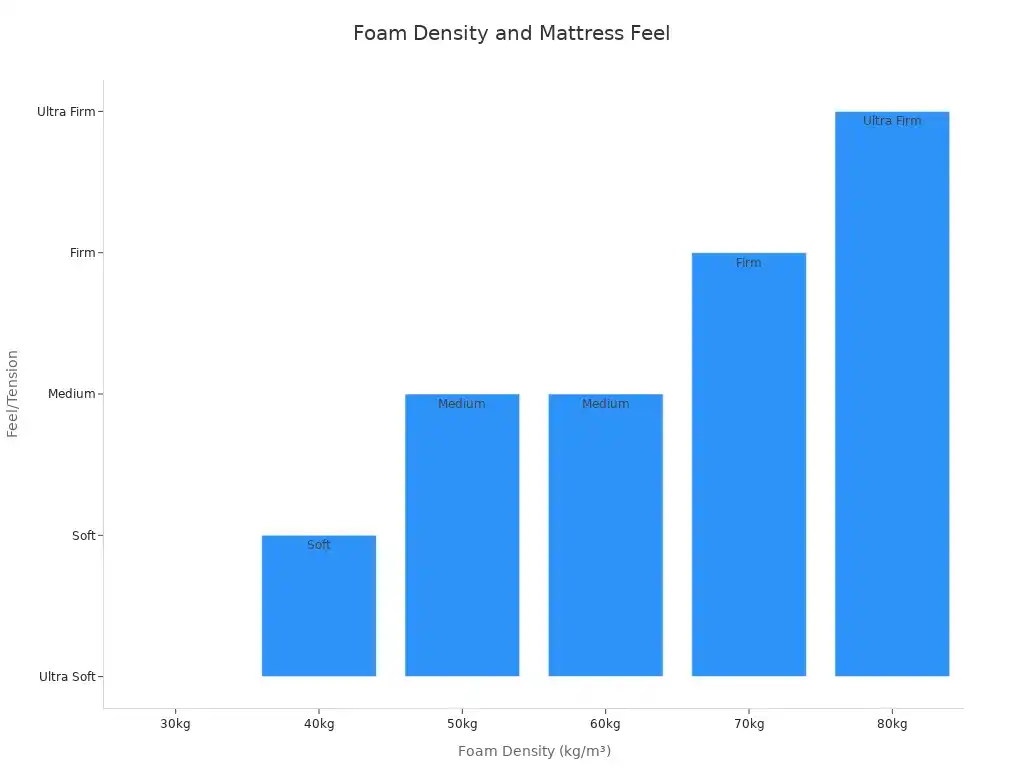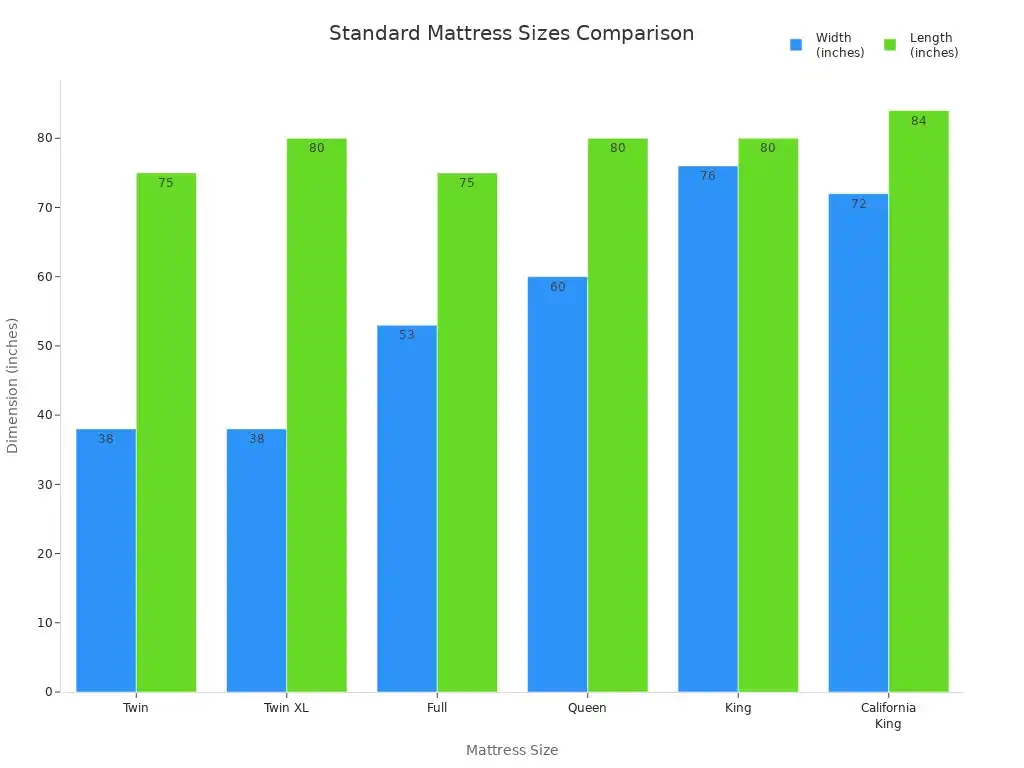Address
No.3 Chengcai Road, Leliu Town, Shunde District, Foshan City, Guangdong, China 528322
Address
No.3 Chengcai Road, Leliu Town, Shunde District, Foshan City, Guangdong, China 528322
Choose a mattress high quality for restful sleep by focusing on support, durability, safe materials, and cooling features tailored to your needs.


You want to wake up feeling good and without pain. Choosing the right mattress high quality can really help your sleep. Most people think a comfy mattress is very important for good sleep. In fact:
Almost 30% still feel some pain from their mattress.
Your body type, how you sleep, and what feels good to you all matter when picking a mattress high quality. Studies show medium-firm mattresses often help with pain and sleep for many people. But no one mattress is perfect for everyone. To get restful sleep, you need to find a mattress high quality that works best for you.
Mattress Type | Key Findings | Impact on Sleep Quality |
|---|---|---|
Medium Firm | Helped with pain and movement for people with long-term pain | Better sleep and comfort |
Soft | More body misalignment for heavier people | May lower sleep quality |
Firm | Mixed results for sleep | Not best for everyone |
A comfy mattress is essential for good sleep. Aim for a medium-firm mattress to support your spine and reduce pain.
Look for high foam density (50kg to 70kg) in your mattress. This ensures durability and comfort over time.
Check for safety certifications like GOTS and CertiPUR-US. These ensure your mattress is free from harmful chemicals.
Consider breathability features like cooling fabrics or airflow systems. These help keep you comfortable and cool at night.
Test mattresses in-store for at least 20 minutes. This helps you find the right fit for your sleep style and comfort needs.
When you shop for a mattress high quality enough to give you restful sleep, you want to know what really matters. Let’s break down the most important features you should look for.
You need a mattress that keeps your spine in a natural position all night. If your mattress sags or feels too hard, your back and neck can hurt in the morning. Here’s why spinal alignment matters:
A good mattress supports your body and helps your spine keep its natural curve.
When your spine stays straight, your muscles and joints can relax.
If your mattress is too soft, your body sinks in and your spine bends in weird ways.
If your mattress is too firm, it can push your spine out of line and cause pain.
Medium-firm mattresses often work best for most people. They help reduce pain and improve sleep quality.
Tip: When you lie down, check if your spine feels straight and supported. If you feel pressure or sagging, the mattress may not be right for you.
A mattress high quality should last for years without losing its shape. Foam density tells you how strong and long-lasting a mattress will be. Higher density means better support and less sagging over time. Here’s a quick guide to foam density and how it feels:
Foam Density (Memory, Hybrid or Latex) | Feel/Tension |
|---|---|
30kg | Ultra Soft |
40kg | Soft |
50kg | Medium |
60kg | Medium |
70kg | Firm |
80kg | Ultra Firm |

If you want a mattress high quality enough to last, look for foam density around 50kg to 70kg. This range gives you a good mix of comfort and durability. Ultra-soft or ultra-firm foams may wear out faster or feel uncomfortable for most people.
You spend hours every night on your mattress, so you want it to be safe. Some mattresses use chemicals that can cause allergies or breathing problems. Look for these certifications to make sure your mattress high quality is also safe for you and your family:
Certification | Description |
|---|---|
GOTS Certified | Made from at least 95% organic materials, no toxic chemicals, no child labor. |
GOLS Certified | Latex with over 95% organic content, strict environmental and social rules. |
MADE SAFE | Checks for over 6,500 harmful substances, ensures non-toxicity. |
GREENGUARD Certified | Low emissions of VOCs, better indoor air quality. |
OEKO-TEX Certified | All parts are free from harmful substances. |
CertiPUR-US | Polyurethane foam with no harmful chemicals. |
Note: Always check the label or product page for these certifications. They help you avoid unwanted chemicals and make sure your mattress meets high safety standards.
No one likes waking up sweaty or hot. A mattress high quality should help you stay cool and comfortable all night. Some materials and technologies work better than others for breathability and cooling. Here’s a quick look at what to look for:
Material/Technology | |
|---|---|
Graphite-infused rubber | Great for cooling. |
Microdiamond-infused layers | Moves heat away from your body. |
Tencel | Pulls moisture and heat away. |
Bamboo | Makes your bed cooler and more comfy. |
Natural rubber | Lets air flow better than memory foam. |
Gel memory foam varieties | Uses gel to keep you cool. |
PCM technology | Helps control temperature, perfect for hot sleepers. |
Cooling fabrics | Lets air pass through, keeps you comfy in any weather. |
Airflow system | Improves ventilation and keeps moisture balanced. |
If you get hot at night, look for mattress types with cooling layers or breathable fabrics. These features help you sleep better and wake up feeling fresh.
Tip: Touch the mattress surface in the store. If it feels cool and airy, it probably has good breathability.
A mattress high quality stands out because it supports your spine, lasts for years, uses safe materials, and keeps you cool. When you know what to look for, you can spot the best mattress types for your needs and sleep style.

Choosing the best mattress can feel confusing with so many options out there. Let’s break down the most common types of mattresses so you can find what fits your sleep style.
Innerspring mattresses use coils for support. You might like these if you want a bouncy feel and strong airflow. Here’s what you should know:
Innerspring mattresses usually don’t last as long as latex mattresses.
The way the mattress is built, like if it’s flippable, changes how well it supports you.
The top layers wear out first, which can affect comfort and support.
If you want a classic feel and good airflow, innerspring could work. But if you want the best mattress for long-term use, you might want to look at other types of mattresses.
Memory foam mattresses shape to your body. They’re popular for pressure relief and motion isolation. Here’s a quick look at the pros and cons:
Advantage | Description |
|---|---|
Pressure Relief | Spreads out your weight and eases pressure on joints. |
Motion Isolation | Stops movement from waking up your partner. |
Durability | High-density foam can last 8-12 years. |
Disadvantage | Description |
|---|---|
Heat Retention | |
Poor Deep Support | Might not support heavier parts of your body well. |
Adjustment Time | Takes a while to bounce back when you move. |
Some memory foam mattresses also have a smell at first or may not support you if the foam is low quality.
Latex mattresses stand out for comfort and allergy resistance. If you have allergies, this could be the best mattress for you. Here’s why:
Natural latex fights off mold and dust mites.
It lets air flow, so you stay cool and dry.
Synthetic latex gives a steady, even feel if you can’t use natural latex.
You get a mix of support, comfort, and a clean sleep space with this type.
Hybrid mattresses mix coils with foam or latex. You get the best of both worlds. Here’s how they compare to other types of mattresses:
Feature | Hybrid Mattresses | Traditional Mattresses |
|---|---|---|
Support | Personalized for different sleep styles | Same support everywhere |
Durability | Wears out faster | |
Motion Isolation | Great for couples | Not as good |
Pressure Relief | Eases pain without losing support | Not as effective |
You might like hybrids if you want comfort, support, and less motion transfer.
Smart and adjustable mattresses use new tech to help you sleep better. Some features include:
Feature | Description |
|---|---|
Automatic Adjustments | Changes firmness as you move. |
Customizable Zones | Lets you set different feels for each part of your body. |
Wellness Solutions | Connects to apps for sleep tracking and tips. |
AI Technology | Senses and responds to your sleep needs in real time. |
If you want the best mattress with the latest features, smart and adjustable types of mattresses give you control and comfort.
You have many choices when it comes to the best mattress. Think about your needs and try different types of mattresses to see what feels right for you.

Finding the perfect mattress starts with how you sleep. Your sleep position, body type, and comfort needs all play a big part. Let’s break down what you need to know so you can choose the right mattress for your best rest.
If you sleep on your side, you put more pressure on your shoulders and hips. You need a mattress that cushions these spots but still supports your body. The wrong mattress can cause sore joints or numb arms in the morning.
Look for a setup with firm coils, a medium middle layer, and a soft top layer. This combo gives your hips support and lets your shoulders sink in just enough.
Some sales staff suggest a Firm Coil/Firm Latex/Soft Top or Firm Coil/Medium Latex/Soft Latex. These setups help your hips stay level and prevent shoulder pain.
Tip: If you wake up with sore shoulders or hips, your mattress might be too firm or too soft. Try a mattress with a softer top layer for better pressure relief.
Back sleepers need a mattress that keeps the spine straight and supports the lower back. If your mattress is too soft, your hips might sink in, which can hurt your back. If it’s too firm, your spine won’t curve naturally, and you might feel pressure in your lower back.
A medium firmness mattress helps keep your spine in line and reduces pressure points.
If you want a natural feel, latex mattresses give you both bounce and firmness, which helps your spine stay happy.
Note: If you have back pain, avoid mattresses that are too soft or too hard. Medium firmness levels work best for most back sleepers.
Sleeping on your stomach can put stress on your neck and lower back. You need a mattress that keeps your body flat and stops your hips from sinking.
Choose a mattress that feels firm enough to hold up your hips and chest.
Too much softness can make your back arch, which leads to pain.
Tip: If you sleep on your stomach, try placing a thin pillow under your hips for extra support.
Do you toss and turn at night? You’re a combination sleeper. You need a mattress that adapts quickly as you move.
Mattresses that respond instantly to movement work best for you.
A 13-inch mattress with a 3-inch GelFlex Grid adapts to your body as you change positions.
Hybrid mattresses give you the bounce of coils and the support of foam or latex, making it easier to move around.
Tip: If you wake up often because you can’t get comfy, try a hybrid or a mattress with a responsive top layer.
Your body weight changes how a mattress feels. What works for one person might not work for another. Here’s a quick guide to help you choose a mattress that fits your body:
Body Weight | Suggested Firmness |
|---|---|
Lightweight (under 130 lb) | 6/10 |
Average (130 – 230 lb) | 6.5/10 |
Heavyweight (over 230 lb) | 7/10 |
If you’re lighter, a softer mattress might feel just right. If you’re heavier, you’ll need more support to keep your spine straight.
Note: Heavier sleepers should avoid ultra-soft mattresses. These can sag and cause back pain.
Mattress firmness levels matter more than you might think. The right firmness keeps your body supported and helps you sleep better.
Mattress firmness is measured on a scale from 1 to 10. One is super soft, and ten is extra firm.
Picking the right firmness can stop pressure points and help you wake up pain-free.
The right firmness supports your weight evenly and keeps your spine in line.
If you have back pain, the right mattress firmness can make a big difference. Too soft or too firm can make pain worse.
Tip: When you choose a mattress, try different mattress firmness levels in the store. Spend at least 20 minutes lying in your favorite sleep position.
When you choose the right mattress for your sleep style, you get better rest and wake up feeling good. Think about your sleep position, body type, and what feels best for you. Avoid mattresses that are too soft or too firm, especially if you have back pain. The right mattress can change the way you sleep every night.
Choosing the right mattress size can make a big difference in your sleep comfort. If you share your bed or just like to stretch out, you want enough space. Here’s a quick guide to standard mattress sizes:
MATTRESS SIZE | DIMENSIONS (inches) | BEST FOR | OTHER CONSIDERATIONS |
|---|---|---|---|
Twin | 75 x 38 | Kids, smaller adults | Too small for someone over 6’ tall |
Twin XL | 80 x 38 | Taller adults, couples | More comfortable for taller people |
Full | 75 x 53 | Single sleepers | Can be cramped for two adults |
Queen | 80 x 60 | Couples, individuals | Good for most sleepers |
King | 80 x 76 | Couples, families | Spacious for multiple sleepers |
California King | 84 x 72 | Taller individuals | Extra length for height |

No one likes waking up sweaty. Some mattress technologies help you stay cool at night. Outlast® fabric controls heat and moisture. Latex keeps a neutral temperature, which is great if you get hot. Innerspring mattresses let air flow through the coils. Hybrids with cooling gel foam also work well.
If you share your bed, motion isolation matters. A mattress with good motion isolation keeps you from feeling your partner’s movements. You both get better sleep, even if one of you tosses and turns or gets up early.
Motion isolation means less disturbance from your partner.
Both of you can enjoy uninterrupted sleep.
This is helpful if you have different sleep schedules.
Strong edge support helps your mattress last longer. Reinforced edges stop sagging and make it easier to sit or sleep near the edge. You get more usable space and better comfort.
Tip: If you like sitting on the edge of your bed, look for a mattress with strong edge support.
When buying a mattress for two, think about both people’s needs. Here’s what to look for:
Motion transfer control so you don’t wake each other.
A mattress that fits both firmness preferences.
Support for different sleeping positions.
Targeted support for partners with different weights.
If you have allergies, you want a mattress that keeps dust mites away. Memory foam and gel foam resist dust mites. Hybrid mattresses with hypoallergenic foam and good airflow help reduce moisture and allergens. Look for certifications like CertiPUR-US for low emissions.
When you visit a store for mattress shopping, you want to make the most of your time. Here are some tips to help you find the right fit:
Wear loose, comfy clothes so you can move and stretch out.
Spend at least 20 minutes lying on each mattress. Give your body time to adjust and notice how it feels.
Try different sleep positions. Roll over, sit up, and lie on the edge to check support and comfort.
Notice if the mattress feels hot or cool. Good temperature control matters for restful sleep.
If you share your bed, bring your partner. Test for motion transfer and see if you both feel comfortable.
Ask the staff about the mattress’s materials, durability, and any safety certifications.
Tip: Don’t rush. Your body needs time to sense if a mattress will work for you night after night.
Shopping for a mattress online can feel tricky, but you can make it easier:
Think about your sleep needs. Do you get hot at night? Do you have pressure points?
Know your sleep position. Side, back, stomach, or a mix? This helps you pick the right type.
Check the mattress materials and what makes them special.
Measure your bedroom space before you buy.
Read about the trial period and return policy. Make sure you can test the mattress at home.
Compare prices, but also look at quality and how long the mattress will last.
Note: Always read reviews and check for clear details about mattress trial periods.
Understanding warranties and the trial period helps you avoid surprises. Here’s a quick guide:
Aspect | Details |
|---|---|
Warranty Importance | Warranties matter, but don’t let them be your only reason to buy. |
Common Warranty Terms | Most cover defects and get less valuable over time as the mattress wears. |
Trial Period Length | Most trial periods last at least 100 nights, giving your body time to adjust. |
Return Policy | Mattress trials let you return the mattress after sleeping on it, not just if it’s unused. |
Comfort Guarantee | Some brands offer comfort guarantees instead of a trial period, focusing on adjustments. |
You want a mattress with a fair warranty and a long enough trial period to really test it out. Mattress trial periods usually last three to four months, so you can see if it’s right for you.
Return policies can be very different from store to store. Here’s a look at how some big retailers handle returns:
Retailer | Trial Period | Warranty | Minimum Required | Return Conditions |
|---|---|---|---|---|
Amazon | 100 days | N/A | N/A | Must be unopened and in original packaging. |
Bear | 120 nights | Lifetime | 30 nights | Only one return per customer during the trial period. |
Brooklyn Bedding | 120 nights | 10 years | 30 nights | Full refund or exchange within the trial period. |
Casper | 100 nights | 10 years limited | 30 nights | Free returns and full refunds during the trial period. |
Most mattress trial periods let you sleep on the mattress before deciding. Standard return policies often require the mattress to be unused, but mattress trial periods give you more freedom. Always check the details before you buy.
You might wonder how much you should spend on a mattress. Prices can range from a few hundred dollars to several thousand. You don’t need to buy the most expensive mattress to get good sleep. Most people find a comfortable, durable mattress in the $800 to $1,500 range for a queen size. If you want extra features like cooling layers or organic materials, you may pay more. Always set a budget before you shop. Think about what matters most to you—comfort, support, or special features.
Tip: Don’t let price alone decide for you. Focus on what helps you sleep better and feel rested in the morning.
Mattress ads can sound impressive, but not every claim means better sleep. You want to spot real quality, not just clever marketing. Here’s a table to help you see what matters:
Indicator | Description |
|---|---|
Companies should let you see how they make their mattresses. This helps you check quality. | |
Use of quality materials | Look for strong, long-lasting materials. These help your mattress last and stay comfortable. |
Verifiable features | Ask questions and check if the mattress really has the features the company promises. |
If a company hides details or uses lots of buzzwords, be careful. Real quality stands out when you can check materials and features yourself.
You don’t always need the fanciest mattress. Sometimes, saving money makes sense. Other times, investing in a premium mattress pays off. Here’s when you might want to spend more or less:
Invest in a premium mattress if:
You need special features like cooling or pain relief.
You want better support for sore joints.
You want a mattress that lasts many years.
Save with a budget mattress if:
You’re not sure what type you like.
You want to try a mattress before spending a lot.
You need a temporary solution.
Think about your needs and how long you want your mattress to last. Sometimes, spending a little more now saves you money and trouble later. If you’re unsure, start with a budget-friendly option and upgrade when you know what works best for you.
You now have the tools to pick a mattress high quality enough for a good night’s sleep. Start by thinking about your sleep style, body type, and what feels best. Use these tips to test mattresses and compare features. Trust your comfort and needs.
Remember, investing in the right mattress means you wake up refreshed and ready for your day.
Most mattresses last 7 to 10 years. If you wake up sore or see sagging, it’s time for a new one. Trust how your body feels each morning.
You want a medium-firm mattress for back pain. It supports your spine and eases pressure. Try different types in-store to see what feels best for you.
Yes, you can put a mattress on the floor. Make sure the floor stays dry and clean. Air out your mattress often to prevent mold and dust buildup.
Most warranties cover sagging if it’s deeper than a set limit, usually 1 inch or more. Always check the warranty details before you buy.